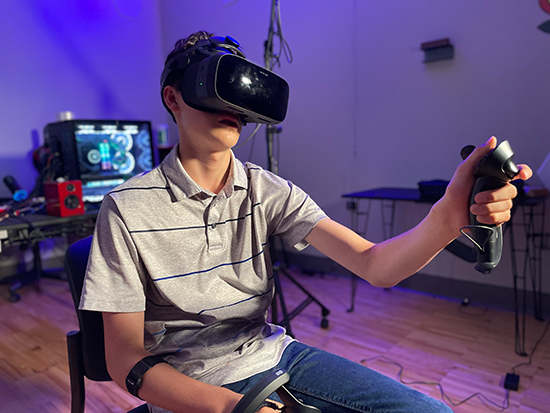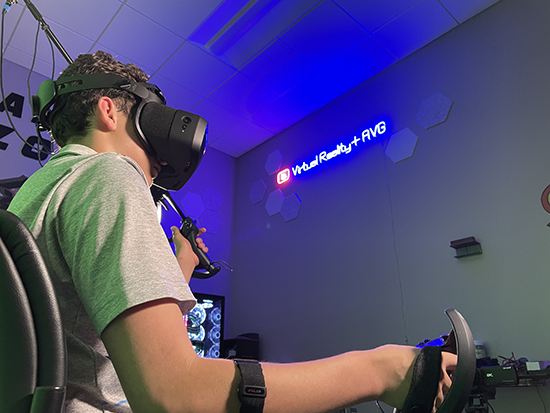 UAB researchers are combining behavioral change theories, telemedicine and extended reality as they work to improve the physical and mental health of children with disabilities. (Photography: Byron Lai)Researchers at the University of Alabama at Birmingham are using extended reality to help improve the mental and physical health of children with disabilities. Byron Lai, Ph.D., an assistant professor in the UAB Division of Pediatric Rehabilitation Medicine, and the division research team of Ashley Wright, Raven Young and Bailey Hutchinson, combine behavioral change theories, telemedicine and extended reality in their recent research as they work to improve the physical and mental health of children with disabilities.
UAB researchers are combining behavioral change theories, telemedicine and extended reality as they work to improve the physical and mental health of children with disabilities. (Photography: Byron Lai)Researchers at the University of Alabama at Birmingham are using extended reality to help improve the mental and physical health of children with disabilities. Byron Lai, Ph.D., an assistant professor in the UAB Division of Pediatric Rehabilitation Medicine, and the division research team of Ashley Wright, Raven Young and Bailey Hutchinson, combine behavioral change theories, telemedicine and extended reality in their recent research as they work to improve the physical and mental health of children with disabilities.
Physical benefits
Children with disabilities are three times more likely to have cardiometabolic disease versus their peers with no disabilities, according to a study in the World Journal of Diabetes. Lai says there currently are very few options for children with mobility disabilities to perform health-enhancing aerobic exercise.
Extended reality provides an enjoyable and accessible form of aerobic exercise to children. Most importantly, extended reality allows them to exercise at a moderate intensity while using only their arms for movement. This helps children with mobility disabilities to get the amount of exercise they need to improve their cardiovascular health.
Many of the children Lai works with had never participated in a serious exercise program until they joined one of the several extended reality studies provided by the division team at UAB and Children’s of Alabama.
“Extended reality games can provide a high level of immersiveness, and that is something the kids really enjoy,” Lai said. “This leads to high engagement and retention. Because they enjoy these games, they are more likely to stick to a therapy prescription that is built into extended reality.”
Mental benefits
Extended reality helps improve the mental health of children with disabilities as it helps combat social isolation, anxiety and depression.
“In addition to getting the children to exercise, we have found these games provide children with a sense of accomplishment as they are able to engage in games and activities they were unable to do up until this point,” Wright said. “This sense of accomplishment plays a role in improving the child’s mental health, specifically when it comes to coping with anxiety and depression.”
Wright says extended reality allows children to pull themselves away from their reality, distract them from any pain they may be feeling, or virtually escape from their clinic or hospital rooms. This immersion provides them with an engaging activity that, combined with mindfulness and peer-socialization strategies, helps improve their mental health.
“With extended reality, these kids just get to be kids and have fun and get away from all the noise in the world,” Wright said. “Everyone in these extended reality games has full mobility, and they are treated the same way. They are not judged based on their disability. They are just a kid hanging out with other kids.”
Equipment needed
The best part about using extended reality to help improve the health of children with disabilities is that the tools used in Lai and Wright’s research are accessible in the market. With extended reality, children wear head-mounted displays and use controllers to participate in exercises that are adapted to their needs. There are adaptable controller hand and head straps for children who may have limited hand strength. The games used for these extended reality experiences can be found on the headset’s app store and modified to fit the child’s needs. Some of the gaming categories include fitness games, such as boxing or table tennis, rhythmic movement-to-music games, and mindfulness meditation games.
 Extended reality provides an enjoyable and accessible form of aerobic exercise to children. (Photography: Byron Lai)The division’s research studies intentionally utilize off-the-shelf supplies so the program can be replicated in real-world settings. Parents just need to purchase a headset and accessories from their local retailers, purchase games from the headset’s store, and make game setting adjustments to best fit the child’s needs. Some of the settings parents can adjust include turning on “No Fail” mode, turning off “Obstacles,” adjusting height and making games playable with one hand. By adjusting these types of settings, parents can help enhance playability in a seated position.
Extended reality provides an enjoyable and accessible form of aerobic exercise to children. (Photography: Byron Lai)The division’s research studies intentionally utilize off-the-shelf supplies so the program can be replicated in real-world settings. Parents just need to purchase a headset and accessories from their local retailers, purchase games from the headset’s store, and make game setting adjustments to best fit the child’s needs. Some of the settings parents can adjust include turning on “No Fail” mode, turning off “Obstacles,” adjusting height and making games playable with one hand. By adjusting these types of settings, parents can help enhance playability in a seated position.
Safety tips
Extended reality headsets have embedded safety features that include requiring the user to set up a play space that allows plenty of room for movement. If the player goes out of the designated safety zone, the game will project the child’s environment on the headset to prevent injury.
For parents who may be concerned about extended reality’s effects on vision, Lai says short-term studies currently show there is no effect on vision. The main factor parents should consider is the minimum age requirement of 10 years old, established by the headset manufacturer.
Future of Lai’s research
Lai has conducted several virtual reality projects that have been funded by the National Institutes of Health, the Forge AHEAD Center, the Center for Engagement in Disability Health and Rehabilitation Sciences, and the UAB Department of Pediatrics. These projects have allowed Lai to test various extended reality therapies for children in a variety of settings, including the pediatric intensive care unit, physical and occupational therapy clinics, pediatric cancer rehabilitation, participants’ homes, and even local schools. A recently completed study at Pelham High School demonstrated that a clinical program can be delivered safely for children as part of their physical education curriculum at school. The program is run by and for children with disabilities. The success of this program has sparked interest in adopting similar programs in the Trussville City School System.
“Should this project be successful, it could open up a means for employment for youth with disabilities, when the project is delivered on a national scale,” Lai said. “This project is also the first collaborative project with the community by the Division of Pediatric Rehabilitation Medicine at UAB and Children’s of Alabama, which could open doors for further projects and services.”
This project was funded by both the Center for Engagement in Disability Health and Rehabilitation Sciences and the Forge AHEAD Center, which is a regional comprehensive research center dedicated to advancing the prevention and management of cardiometabolic diseases, including obesity, diabetes and hypertension, which disproportionately affect communities in Alabama, Mississippi and Louisiana. CEDHARS was established in 2019 with a mission to perform cutting-edge inclusion science research, train future students and researchers, and develop novel approaches to promoting the health and well-being of children, adults and seniors with disabilities.
Lai and the division team are currently working on two other exciting extended reality projects. One study aims to develop a protocol for improving the physical and mental health of pediatric cancer rehabilitation patients, which was funded by the highly prestigious Kaul Pediatric Research Grant of the UAB Department of Pediatrics. Another study, funded by the National Institutes of Health, is confirming whether an aerobic extended reality exercise program can improve blood-related health among children with cerebral palsy. Lai is awaiting review of a large grant that will improve the mental health of children with disabilities through online peer-networking and mindfulness meditative practices.